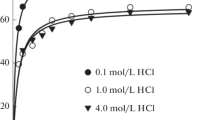Summary
Palladium can be determined volumetrically after separation with α-picolinic or quinaldinic acid by dissolving the complex in an excess of standard potassium cyanide solution and back-titrating the excess of the cyanide by standard silver nitrate solution, potassium iodide being used as the indicator. The method is very rapid and quite satisfactory. With α-picolinic acid only 2 to 15 mg of palladium can be determined accurately and in the case of quinaldinic acid the amount of palladium that can be estimated is from 2 to 8 mg. Higher amounts of palladium give results slightly lower than the theoretical values.
Similar content being viewed by others
References
Majumdar, A. K., and J. G. Sen Gupta: Z. analyt. Chem. 161, 100 (1958).
Majumdar, A. K., and J. G. Sen Gupta: Z. analyt. Chem. 161, 104 (1958).
Author information
Authors and Affiliations
Rights and permissions
About this article
Cite this article
Majumdar, A.K., Sen Gupta, J.G. α-Picolinic acid and quinaldinic acid in the separation and volumetric determination of palladium. Z. Anal. Chem. 161, 179–181 (1958). https://doi.org/10.1007/BF00451009
Received:
Issue Date:
DOI: https://doi.org/10.1007/BF00451009




